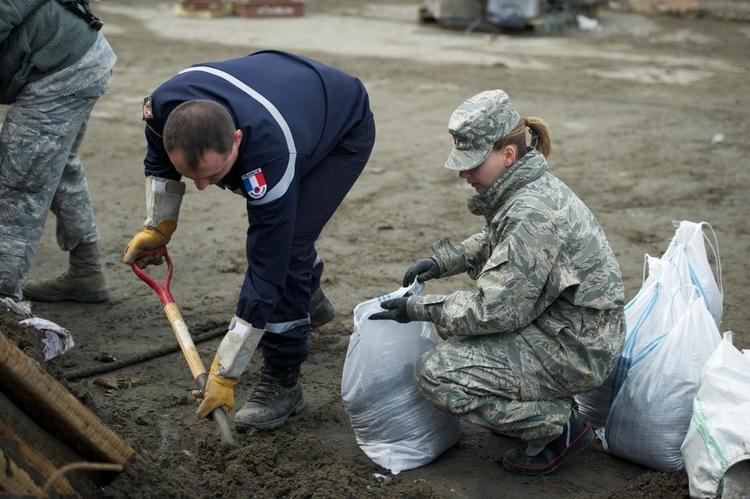Country United States | ||
 | ||
Active 1942-1955; 1978-present Garrison/HQ Joint Base Elmendorf-Richardson, Alaska Engagements Southwest Pacific Theater | ||
The United States Air Force's 301st Intelligence Squadron is an intelligence unit located at Joint Base Elmendorf-Richardson, Alaska.
Contents
- Mission
- 1st Radio Squadron Mobile
- 6920th Electronic Security Group
- 301st Intelligence Squadron
- Lineage
- Assignments
- References
The squadron's first predecessor was organized in 1942 as the 138th Signal Radio Intelligence Company, a signals intelligence unit. The company served in the Southwest Pacific Theater during World War II, then moved to Japan to join the occupation forces. Redesignated 1st Radio Squadron, Mobile in 1946, the unit transferred from the United States Army to the United States Air Force in 1949 and served in Japan until inactivation in May 1955.
The squadron's other predecessor was organized at Misawa Air Base, Japan in 1978 as the 6920th Security Squadron. In October 1993, the two units were consolidated as the 301st. It continued to serve at Misawa until June 2014, when it moved to its present location.
Mission
The squadron as partner of the 381st Intelligence Squadron at the Alaska Mission Operations Center. The unit’s mission is to collect, process, analyze, and report signals intelligence on adversary operations, capabilities and intentions. Additionally, unit personnel conduct communications, maintenance and administrative actions supporting site operations and as provide tactical analytic support to combat units.
1st Radio Squadron, Mobile
The first predecessor of the squadron was activated in February 1942 as the 138th Signal Intelligence Company at Fort George Wright, Washington. It received it initial cadre on 25 February drawing from the 404th Signal Company, Aviation; 434th Signal Maintenance Company, Aviation and 39th Signal Platoon, Air Base. However, it was April before a substantial number of people were assigned to the company. The company continued training at Fort Wright until May 1943, when they departed for shipment to the Southwest Pacific, Staging through Fort Dix, New Jersey. On 13 May, the company boarded the USAT Uruguay for a monthlong shipment through the Panama Canal to Brisbane, Australia.
In August 1942, the squadron moved forward to Port Moresby, New Guinea to begin operations. The squadron continued radio intercept operations of Japanese radio transmissions until VJ Day.
Following the war, the unit was transferred from the Army Signal Corps to the Air Corps and redesignated the 1st Radio Squadron. However, it remained part of Army Security Agency for more than a year after the United States Air Force became independent, not transferring to United States Air Force Security Service until 1 February 1949. The squadron remained in Japan through the end of the Korean War and was inactivated in May 1955, and its mission, personnel and equipment transferred to the 6921st Radio Squadron, Mobile.
6920th Electronic Security Group
The second squadron antecedent was activated as the 6920th Security Squadron at Misawa Air Base, Japan in October 1978. When USAF Security Service became Electronic Security Command, the squadron was expanded to group size as the 6920th Electronic Security Group.
In October 1992, the unit became one of the operational components, with the Naval Security Group Activity, Misawa, a Marine company, and the 750th Military Intelligence Company, in the Misawa Cryptologic Operations Center.
301st Intelligence Squadron
In October 1993, the 1st Radio Squadron (which had been disbanded in 1985), was reconstituted and consolidated with the 6920th Group and the consolidated squadron was named the 301st Intelligence Squadron. The squadron mission at Misawa was to process time-critical combat information for unified and specified commands and the National Command Authorities. It conducted satellite communications processing and reporting. The 301st provided sensitive communications support to aircraft. It operated and maintained $500,000,000 of electronic equipment.
After the massive tsunami and devastating earthquake measuring 9.0 on the Richter Scale struck the coast of Japan in 2011, Airmen of the 301st devoted countless hours alongside other Americans and Japanese during Operation Tomodachi by assisting with clean-up and restoration efforts throughout Japan.
In June 2014, as the Misawa operations center closed and intelligence personnel there were reduced by more than 500 people, the squadron moved from Misawa to Joint Base Elmendorf-Richardson when the intelligence center at Misawa closed.
